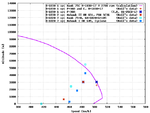The added weight is IN FRONT OF THE COG. Removing weight from BEHIND OF THE COG does make things worser! You need to elongate the hull and install dead weights (armour?) as far aft as possible to counter this. Or You move the wing forward.
Remember also that it´s engine dry weight, not netto weight increases. The support frames needs to be enforced to cope with the heavier loads and torque effects produced by the larger engine, too.
Sorry if I haven't make myself clear (English is not my 1st language). The point was to put more armor fuel tanks behind pilot, and remove the radio further back.

